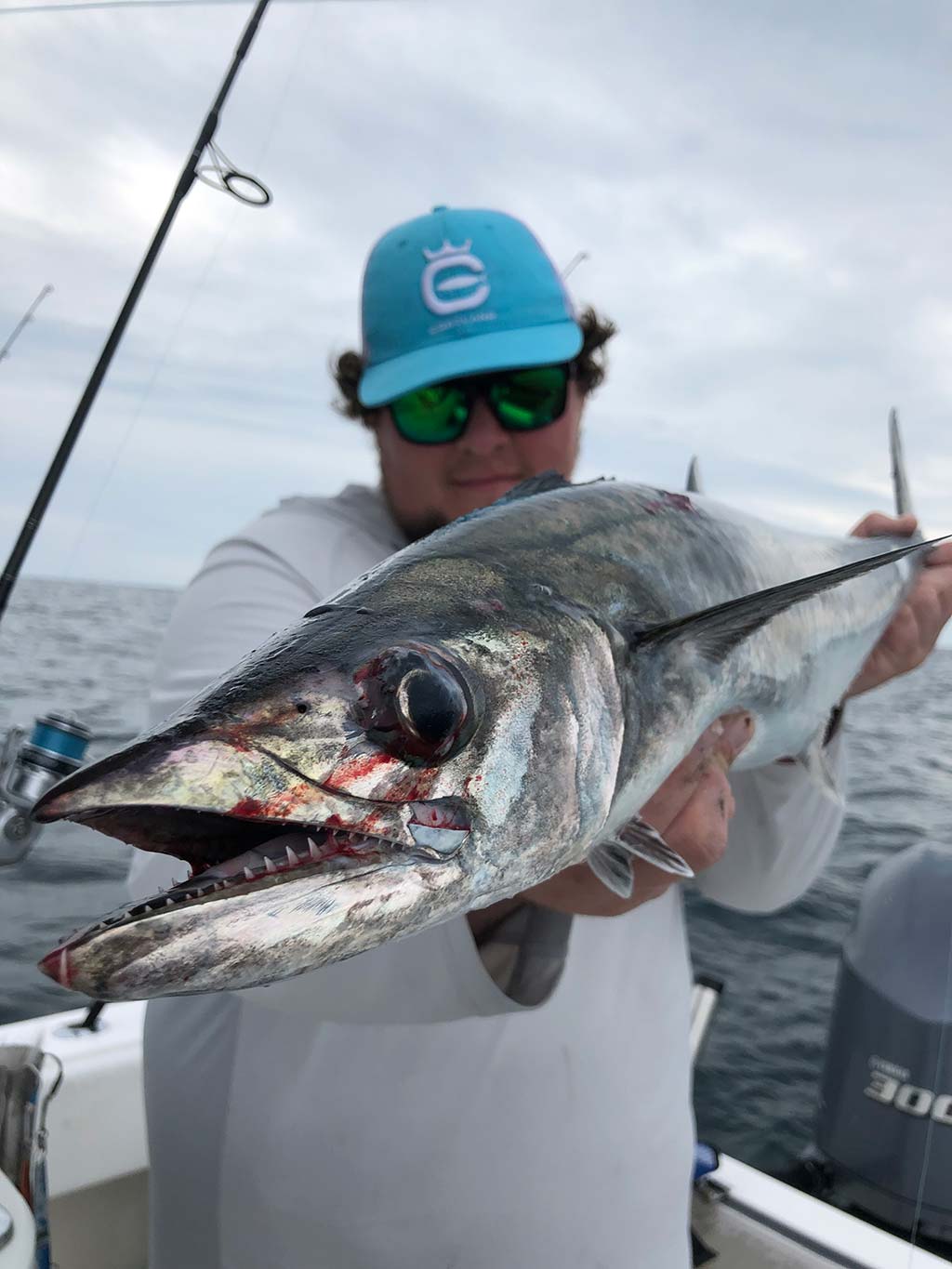
You don’t have to hit the canyons to find summer pelagic species.
There’s something to be said about the view of what someone would use as a traditional fluke rod doubled over and screaming out line from a pelagic predator. Normally, the conversation of these kinds of species revolves around long boat rides, heavy gold conventional reels, and big expenses.
However, learning how to target inshore pelagics can put you right in the mix of drag peeling fun only a few miles out and without having to invest in a true offshore arsenal. A couple of medium-heavy conventional reels and a little time to do some rigging can have you ready to chase down these summertime visitors!
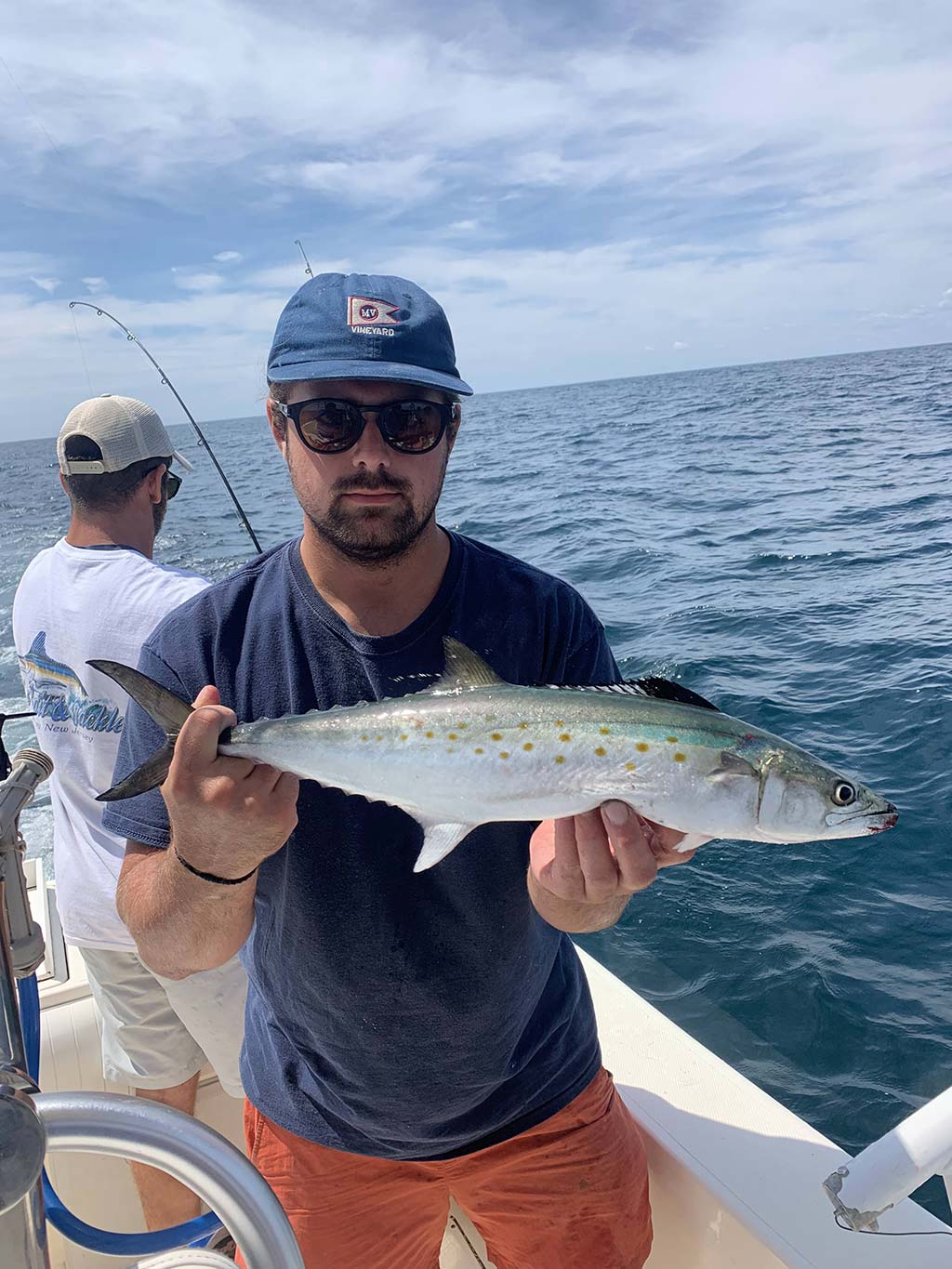
The Target Species
In typical summers, once July hits and our water temps hit that 70-degree mark, our inshore lumps start to fill up with these awesome fish. The tried and true bonito and false albacore are usually the first to show up. The Atlantic bonito have small needle like teeth and most of their body is covered in broad black stripes against a bright blue/green and silver background. These tend to be in the 3- to 6-pound range, and make for delicious table fare.
The false albacore or little tunny is a well-known species up and down the coast that has a small patch of blue/green and black lines on the back and three black spots on the belly; they tend to be a little bigger than the bonito averaging about 5 to 10 pounds. These are considered inedible but make for great sport, especially on light tackle.
As the water continues to warm up, Spanish mackerel, king mackerel, and mahi all make a showing. Spanish mackerel are about 2 to 4 pounds and have a turquoise back with yellow spots throughout the bottom of their body. They also make great table fare. King mackerel – known throughout the Southeast states as kingfish – will range anywhere from 5 to 15 pounds and have a grayish/silvery body with a very distinct lateral line. They are considered to be okay table fare as long as they are iced and bled immediately. Both of these mackerel come with a serious set of teeth, and should be handled as such.
Mahi are categorized by a bright yellow body with blue and green spots, and have the widest diversity of size with most being 2- to 5-pounders but many people stumble upon 10- to 20-pound class fish as well and make for some of the best eating fish in the ocean. Finally, keep in mind while fishing these areas that you are subject to some unexpected species. Where there is food and good water, it should never be discounted that you can stumble across some inshore bluefin tuna which is why it is of utmost importance to keep your gear in the best condition you can.
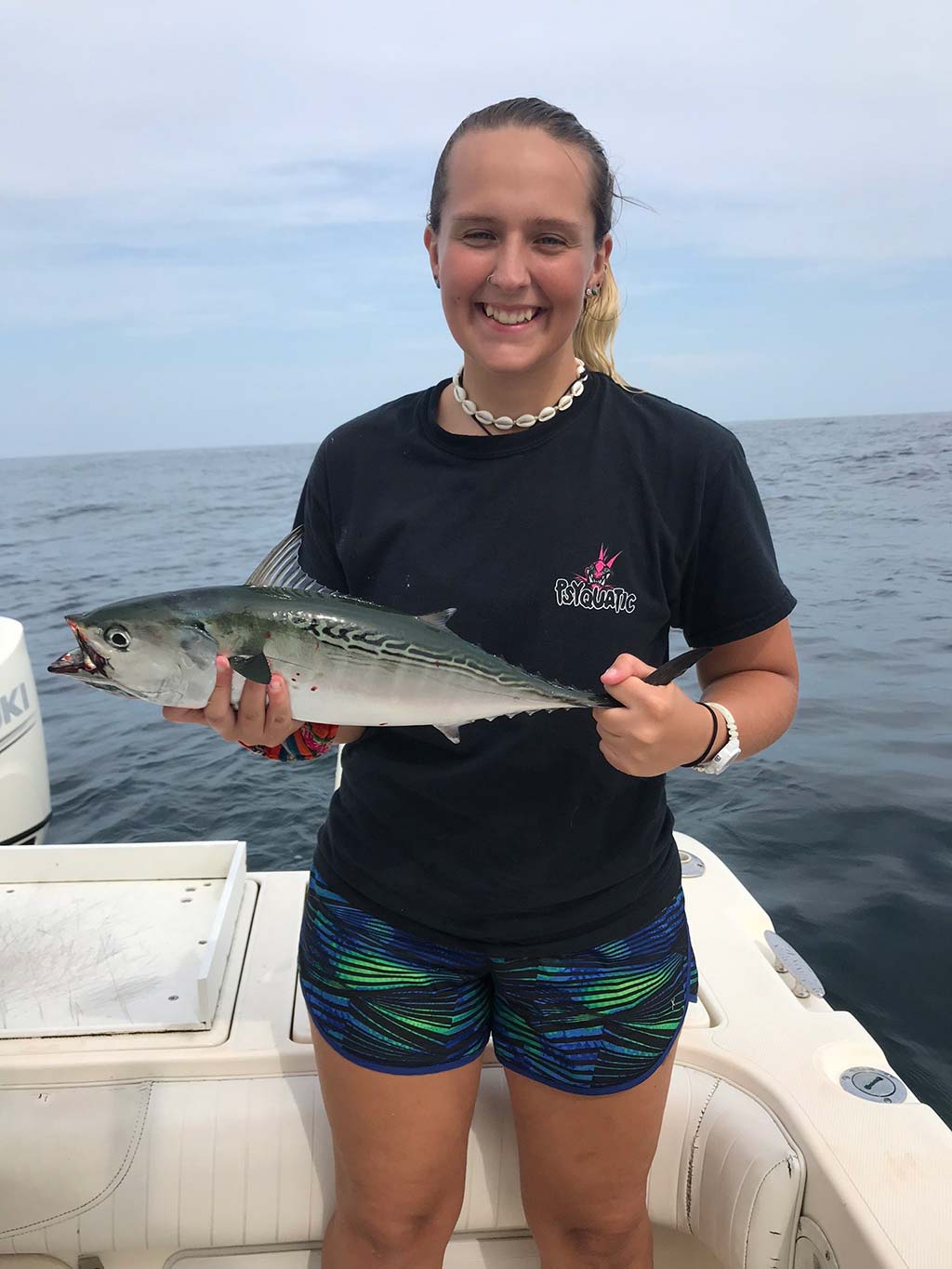
Geared Up For Action
The normal outfits for this kind of fishery are not any heavier than what you would use to do some ocean fluking. Rod wise, I am looking for something in the 6- to 7-foot range, that has a medium to medium heavy rating, 15- to 40-pound line rating, and a lure rating of 1/2 to 4 ounces. While many rods fit this bill, I would give the nod to the Lamiglas Bluewater BW7030C. When pairing up a reel, those in the 15- to 20-pound class are plenty. All of the reels we use for this fishery are the Avet MXs. Day in and day out these reels prove themselves for getting the job done against these powerful fish.
You can spool up a few different ways depending on your preference for braid or monofilament. If braid, I would recommend 40-pound Cortland Master Braid with a 100-yard topshot of 40-pound mono. If mono, I would fill with straight 25-pound test. Each rod should be rigged with a small ball bearing snap swivel to make for easy on and off of the lures.
The majority of this fishery is done on the troll. In terms of the spread, we rarely exceed using six rods. Profile size is very important when it comes to targeting these fish, as they tend to eat a large amount of small prey. With most ranging in the 3- to 8-pound range, the bait profile should be around 3 to 5 inches in length. There are not a lot of lures made this size that are meant to be pulled at the high speeds of trolling, so getting creative is sometimes essential.
Our spread for these fish starts with two squid daisy chains. A daisy chain is a very popular trolling lure, but usually made up on a much grander scale. Rather, ours are homemade. Five Boone or Olde Salt 3-1/2-inch teaser squids in pink make up this lure. A 1/4-ounce egg sinker is placed in each squid bulb to help with keeping the lure in the water at trolling speed. Now that these squids are prepped, we rig them with 100-pound mono. Using crimps as stoppers, place the squids along the length of mono about 1 to 1-1/2 feet of space between each. This is done for all but the last, which is armed with a Mustad 34011 3/0 hook.
I use an offshore loop at the top of the rig to making it easy to receive a snap. Next in the spread are two small cedar plugs in either pink mackerel or red head white. DiscountTackleOutlet.com offers up either a rigged or unrigged 4-inch one. If choosing to purchase them unrigged, I prefer to use 100-pound mono and a 3/0 to 4/0 strong long shank hook.
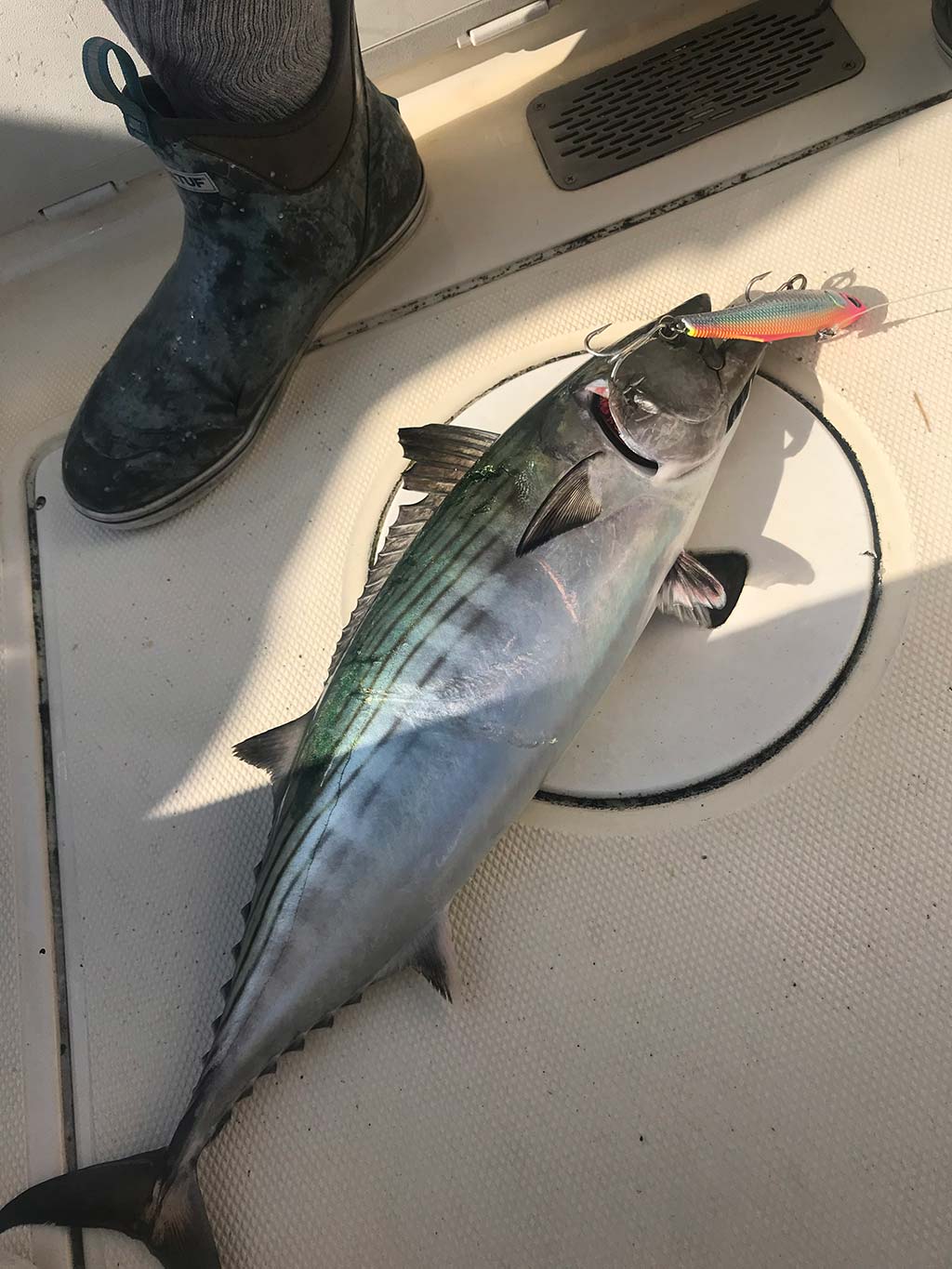
Adjusting Your Spread
Once these four lures are ready to go, it’s time to set them out. Using either release clips or rubber bands, one cedar plug and one squid chain are going to be fished close behind the boat out of the flatline position. In either corner of the boat there will be a place on the transom to place the release clip or rubber band. Run the line through either one and set it back about 30 to 40 feet behind the boat. When a fish hits, it will either break the rubber band or snap free from the release clip.
The next two will be fished out of outrodders, and should be sent pretty far back behind the boat, about 200 to 250 feet back. Now that your two daisy chains and two cedar plugs are in, your last two rods are sort of wild card options for what you want to try. For these I personally fish either a Yo-Zuri Vibe or some other variation of small deep diving plug on one rod; the last is either a Canyon Runner rainbow spreader bar or a skirted ballyhoo. Both of these can be run up the middle and should be placed past the flat line lures but in front of the lures in the outrodders.
Of course, picking your starting location can be the trickiest part of the equation, and it’s where it pays big dividends to do some shopping at the local tackle shops where you may be able to pry some knowledge out of the staff. These guys talk to a lot of the fishermen daily, and are usually in the know about where you can point the bow. Dock chatter can also be a big help, and becoming friendly can pay off bigtime with information.
Once out and on the water, you need to look for signs of life. While information will get you in the right area, fish move, and you will need to find them. Around 2 miles shy of the area I am heading, I like to deploy the spread and troll into the area. The ideal trolling speed is around 6.8 to 7.2 knots. Going the right speed is critical to getting the bite and should be constantly monitored.
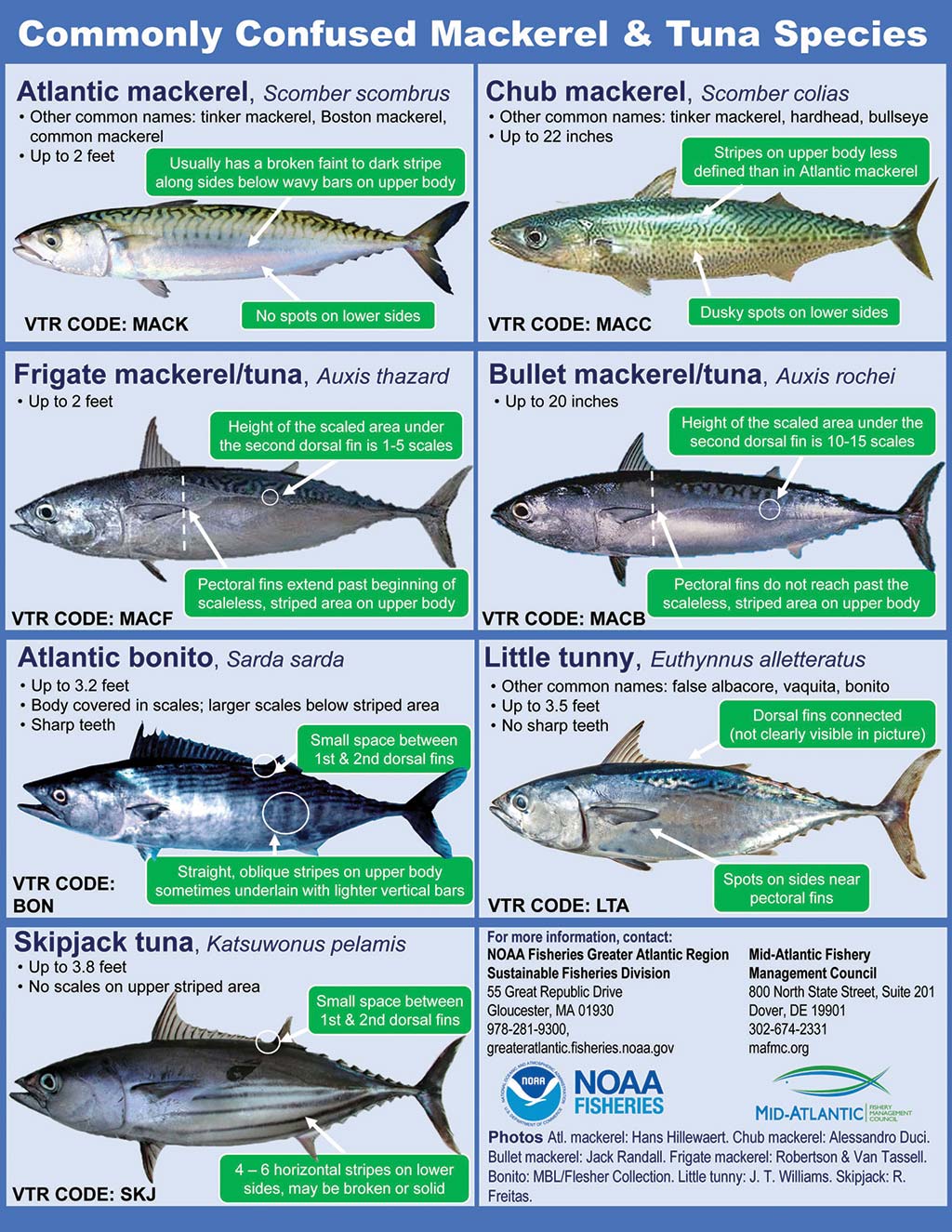
Our Target Destination
Ideally, you’re looking for good water temp, somewhere in that 70- to 74-degree range. Water color is also important, and can be judged by looking in the prop wash. You are looking for blue or blueish, and should say away from green. After finding the right water, scan the surface for “chicks and slicks” which will be evident by small black birds picking at the surface of what looks like sleek oily water. This is indicative of a feed going on down below.
Porpoises, whales, sea turtles, mola mola, sharks, and any other signs of life are all great waypoints to troll around as they all tend to be in the same areas of good water and lots of bait. Finally, using the fish finder to see varying depth as well as any sort of bait and fish marks is a huge help. If you mark fish and bait, it’s always a good bet to drop a point on your GPS to double back over that area. With the spread out, a few key points will always keep you ready to go.
Make sure that drags are set right with the clickers on, you do not want to lose a fish due to a drag being too tight or too lose or miss a bite. Make sure to routinely check the spread if seeing any kind of grass in the water; lures with grass on them will not catch! Keep an eye on the spread constantly to make sure that lines are not getting crossed and tangled. Any of these can cause for a lost fish or a missed opportunity.
There are several mackerel and tuna species you’re apt to encounter on the inshore and midrange grounds off the Jersey Coast during the summer, and knowing the difference can help you keep it legal. In New Jersey, there’s a 23-inch size limit on king mackerel and a three fish bag, while Spanish mackerel has a 14-inch size and three fish per person bag. Of course, if you’re hoping at a shot at bringing home some bluefin, make sure you get your vessel permitted first at hmspermits.noaa.gov.
It is important to note these fish can be caught with bait and lures on the right days. If you stumble upon a large concentration of fish, anchoring up and chumming with fresh spearing can be deadly. For this style, cut the snap swivel off and tie a small two-way swivel on. Use 4 feet of 20- or 30-pound fluorocarbon and tie on a small 1/0 hook. Either hook two spearing through the eyes and float them back, or my personal favorite is to load the live well with live peanut bunker and liveline them out. Small jigs casted and retrieved or jigged at high speeds can also get the bites and make for exciting fishing!
All in all, if you are trying to get in on some pelagic fishing without breaking the bank, New Jersey’s inshore pelagic fishery is hard to beat!



